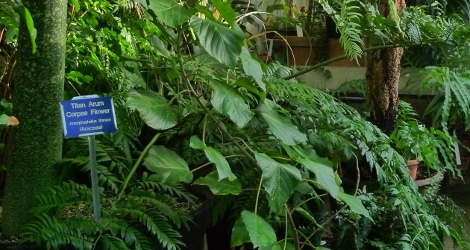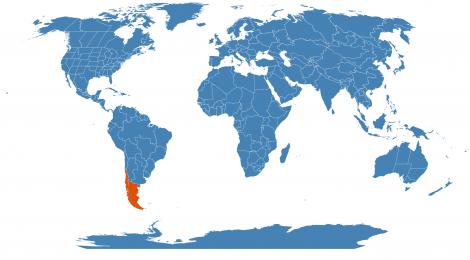Accession Data:
Ugni molinae Turcz.
- Common Name: Uni, Chilean Guava
- Family: Myrtaceae Juss.
- Description: [syn Eugenia ugni; Myrtus ugni]
Indigenous to Chile and Bolivia, this species bears fragrant, purplish red, berry-like fruit. These are edible, though tart, and are often made into jam or conserves. The abundant small, bell-shaped flowers are pink or white with prominent stamens, and are borne in leaf axils. Its dense growth, to about 15 ft (4.5 m) in height, makes Ugni molinae suitable for hedges; it tolerates light shade.
- Uses: Fruit - raw or cooked. An absolutely delicious flavour, it is very aromatic and tastes of wild strawberries. The fruit is about 15mm in diameter and is freely borne even on small plants. Leaves are a tea substitute. The roasted seeds are a coffee substitute.
- Culture: Succeeds in any reasonably good soil including dry ones. Prefers a moderately fertile well-drained loam in a sunny position. Fairly tolerant of maritime exposure. Established plants are drought resistant. Tolerant of trimming, it can be grown as a small hedge in the milder parts of Britain.
Seed - pre-soak 24 hours in warm water and sow February in a greenhouse. Prick out the seedlings into individual pots as soon as they are large enough to handle and grow them on in the greenhouse for at least their first winter. Plant them out into their permanent positions in late spring or early summer, after the last expected frosts.
Cuttings of half-ripe wood, 7 - 10cm with a heel, July/August in a frame. Pot up in the autumn and overwinter in a cold frame. Plant out in late spring. High percentage.
Cuttings of mature wood of the current seasons growth, 7 - 12cm with a heel, November in a shaded and frost free frame. Plant out in late spring or early autumn. High percentage.
Layering.
- USDA Zone: 8-10
Accession Data:
- Accession # 198502403
- Source: John Maugeri ex CRFG
- Provenance: Original plants deemed to be mis-identified. Replaced with plants of presumed correct identity but re-used old accession number. New seed via John Maugeri ex. CRFG
- Accession Date: 10-28-1998
- Bench: 2116 - MED:Mattoral B
- Currently: active - healthy
- Qty: 2 confirmed on 03-12-2025
Classification:
- Division: Magnoliophyta
- Class: Magnoliopsida
- SubClass: rosids
- Order: Myrtales
- SubOrder:
- Family: Myrtaceae
- SubFamily: Myrtoideae
- Tribe: Myrteae
- SubTribe:
Flowering Data:
This accession has been observed in bloom on:| Year | Jan | Feb | Mar | Apr | May | Jun | Jul | Aug | Sep | Oct | Nov | Dec | ||||||||||||||||||||||||||||||||||||||||
|---|---|---|---|---|---|---|---|---|---|---|---|---|---|---|---|---|---|---|---|---|---|---|---|---|---|---|---|---|---|---|---|---|---|---|---|---|---|---|---|---|---|---|---|---|---|---|---|---|---|---|---|---|
| 2025 | ||||||||||||||||||||||||||||||||||||||||||||||||||||
| 2024 | ||||||||||||||||||||||||||||||||||||||||||||||||||||
| 2023 | ||||||||||||||||||||||||||||||||||||||||||||||||||||
| 2022 | ||||||||||||||||||||||||||||||||||||||||||||||||||||
| 2021 | ||||||||||||||||||||||||||||||||||||||||||||||||||||
| 2020 | ||||||||||||||||||||||||||||||||||||||||||||||||||||
| 2019 | ||||||||||||||||||||||||||||||||||||||||||||||||||||
| 2018 | ||||||||||||||||||||||||||||||||||||||||||||||||||||
| 2017 | ||||||||||||||||||||||||||||||||||||||||||||||||||||
| 2016 | ||||||||||||||||||||||||||||||||||||||||||||||||||||
| 2015 | ||||||||||||||||||||||||||||||||||||||||||||||||||||
| 2014 | ||||||||||||||||||||||||||||||||||||||||||||||||||||
| 2013 | ||||||||||||||||||||||||||||||||||||||||||||||||||||
| 2012 | ||||||||||||||||||||||||||||||||||||||||||||||||||||
| 2011 | ||||||||||||||||||||||||||||||||||||||||||||||||||||
| 2010 | ||||||||||||||||||||||||||||||||||||||||||||||||||||
| 2009 | ||||||||||||||||||||||||||||||||||||||||||||||||||||
References (internal):
- EEB Greenhouse Holdings native to: Argentina South / Chile Central / Chile South /
References (external):
- The Plant List (2013). Version 1.1. Accessed 24 February 2015.
- WCSP (2015). World Checklist of Selected Plant Families. Facilitated by the Royal Botanic Gardens, Kew. Accessed 24 February 2015.
- Botanica, Turner & Wasson, 1997, CD-ROM Version
- Plants For A Future Website
- Musial, Kathy; An Introduction to the Geography, Climate, and Flora of Chile; Pacific Horticulture, October 2011. Accessed 20 March 2015.
data regenerated on Wed, 12 Mar 2025 14:18:01 -0400 [bcm v4.0]
Images:

Additional images for this accession:
Click on thumbnails to enlargeCurrent Accessions in the Myrtaceae
Subfamily Myrtoideae
Tribe Eucalypteae
Subfamily Myrtoideae
Tribe Leptospermeae
Subfamily Myrtoideae
Tribe Melaleuceae
Subfamily Myrtoideae
Tribe Metrosidereae
Subfamily Myrtoideae
Tribe Myrteae
- Acca sellowiana


- Eugenia brasiliensis


- Eugenia uniflora

- Myrtus communis `Microphylla'

- Pimenta dioica

- Plinia cauliflora


- Psidium cattleianum


- Psidium guajava


- Ugni molinae

Subfamily Myrtoideae
Tribe Syzygieae
Subfamily Psiloxyloideae
Tribe Heteropyxideae
W/C = Wild Collected
 = indicates flowering in past 14 days
= indicates flowering in past 14 days
 = images available for this accession
= images available for this accession
 = map available for this accession
= map available for this accession
 = accession added within past 90 days
= accession added within past 90 days
